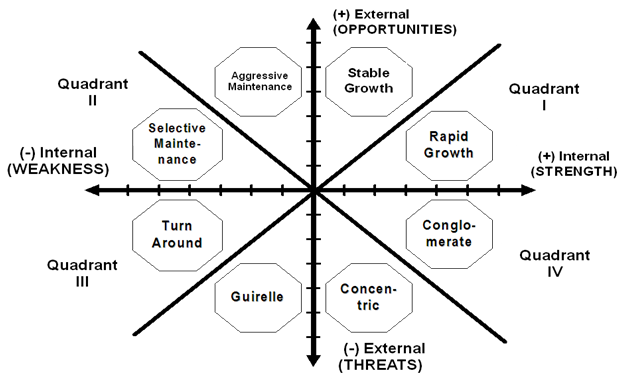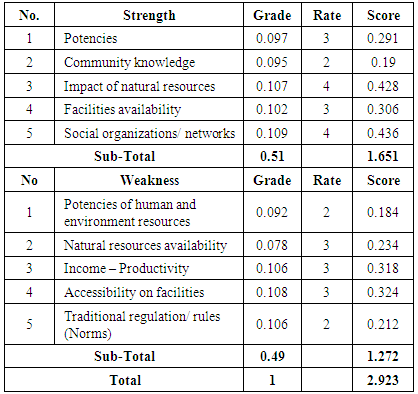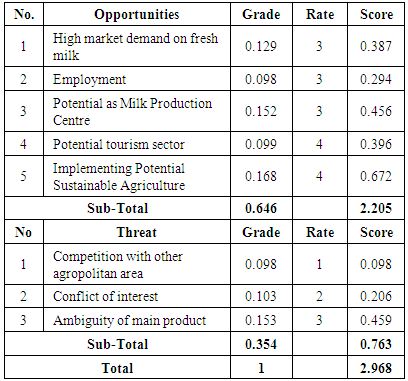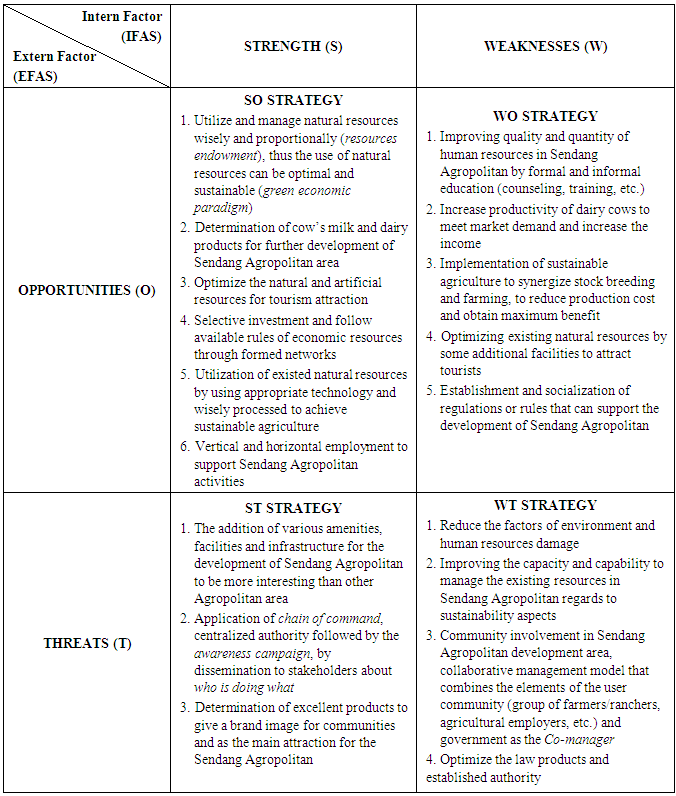-
Paper Information
- Paper Submission
-
Journal Information
- About This Journal
- Editorial Board
- Current Issue
- Archive
- Author Guidelines
- Contact Us
International Journal of Applied Sociology
p-ISSN: 2169-9704 e-ISSN: 2169-9739
2015; 5(3): 113-120
doi:10.5923/j.ijas.20150503.01
Development Strategy of Sendang Agropolitan Area, Tulungagung
Adi Prasetiya1, 2, Suyadi3, Mohammad Bisri4, Soemarno5
1Environmental Sciences and Technology Graduate Program, University of Brawijaya, Malang, Indonesia
2Office of Regional Revenue, Tulungagung Regency, East Java, Indonesia
3Department of Animal Husbandry, Faculty of Animal Husbandry, University of Brawijaya, Malang, Indonesia
4Department of Water Resources Engineering, Faculty of Engineering, University of Brawijaya, Malang, Indonesia
5Department of Soil, Faculty of Agriculture, University of Brawijaya, Malang, Indonesia
Correspondence to: Soemarno, Department of Soil, Faculty of Agriculture, University of Brawijaya, Malang, Indonesia.
| Email: |  |
Copyright © 2015 Scientific & Academic Publishing. All Rights Reserved.
The purposes of this study is to formulate appropriate strategies for preparing regional development and agribusiness system in terms of human resources, natural resources, artificial resources/facilities and infrastructure, and social resources. The basis of the study is problem solving on existed issues in development area of Sendang Agropolitan. Moreover, we also explained the strengths and weaknesses of Sendang Agropolitan and identify the macro environment (external) factor which may affect the Sendang Agropolitan development to generate sustainable recommendations. This research used SWOT analysis and EFAS IFAS. The results show that the development strategies of Sendang Agropolitan is located in Quadrant 1 which indicated an aggressive growth policy (Growth Oriented Strategy) by using Strength Opportunities strategy (SO) and implemented by exploiting existing opportunities and utilizing the strength of Sendang Agropolitan.
Keywords: Agropolitan, EFAS, IFAS, Growth Oriented Strategy, SWOT
Cite this paper: Adi Prasetiya, Suyadi, Mohammad Bisri, Soemarno, Development Strategy of Sendang Agropolitan Area, Tulungagung, International Journal of Applied Sociology, Vol. 5 No. 3, 2015, pp. 113-120. doi: 10.5923/j.ijas.20150503.01.
Article Outline
1. Introduction
- Development of modern urban sector had shown to increase growth in various sectors and locations with high level of productivity. The growth rate of investment and capital accumulation concentrated in the modern sector. The concept will inspire the centre formation of urban growth (growth pole economy). It is expected that the formation of these growth centres will initiate the development to the rear areas (trickle-down process) and equalization will occur automatically on the growth poles of the rear area (hinterland). But in fact, the initiation of development does not occur. Contrary, the massive exploitation of local resources by the central is happening (massive backwash effect), both in terms of human resources, nature, and even capital [1-3].On the other hand, the rear areas becoming deficient area due to the depletion of resources; exploited by the city in sector of natural resources, human and capital resources for progress and development determinant. As a result, the spatial gap between urban and rural occurs and accumulates over time. Moreover, government dominancy in the past was decayed the moral of the rural resident (moral hazard). Policies are often in contradiction to the local area needs. Central policy and moral hazard has led to inefficient allocation of resources, often destruct the social values that paralysed ability and creativity. Moreover those people lose their innovating spirit to develop themself and their residence [4].The new paradigm of development emphasizes on equality and active participation of the community, began with the enactment of Law No. 32 of 2004 on Regional Government and Law No. 33 of 2004 on Financial Balance and the Regional Centre. With these laws, the development will be focused on decentralization aspect. In conjunction with the decentralization of regional autonomy under the Law No. 32 of 2004, it states that the autonomy regional authority regulate and manage the interests of local people initiative based on the aspirations of their own local communities. Therefore, they have a greater authority for managing natural resources, human resources, social resources and artificial resources [5]. Potential resources exploration is a major priority which aims to increase local revenue which is based upon the principles of justice and independence that ultimately improve the society welfare. Resource potential exploration area is a high priority, with the aim to increase local revenue that is based upon the principles of justice and independence that will ultimately improve the welfare of society. Such efforts can be made by combining the capabilities of human resources (human capital) and the use of natural resources by increasing the additional value and physical resources that lead to the increase of the region ability in the implementation of development. Five aspects of these resources can be optimized by concerning the empowerment efforts of local communities through supporting rural financial markets and the rural institution strengthening [6, 7].Indirectly, the development of agricultural sector plays a role in the creation of macro-economic climate through its influence on the rate of inflation. This is largely influenced by the dynamics of food prices, supporting the development of upstream industries through demand for agricultural inputs, agro-industry supply of raw materials, and the development of downstream processing through food and non-food agricultural products’ quality, and the creation of marketing system [8].Tulungagung District is located in East Java. It has been established as agropolitan area accordance with the Regent Decision No. 524 of 2004 and most residents (42.44%) work as farmers [9]. Based on this fact, Tulungagung Goverment made the agricultural sector as a focus of development. Problem of Tulunggung Agropolitan area is the utilization of main product that has competiveness value and is potentially optimized. Internal problems of Tulungagung Agropolitan include the non-optimal supporting infrastructure, lack of government's participation for the Tulungagung Agropolitan development, limited funds, and unprepared Agropolitan society for the developing programs. Therefore, the aims of this research are formulating appropriate strategies for preparing regional development and agribusiness system in terms of human resources, natural resources, artificial resources/facilities and infrastructure, and social resources on solving the problems of Sendang Agropolitan (Tulungagung) area development.
2. Materials and Method
- This research used qualitative approaches by collecting data from field observation and structured interviews. The methods of analysis are SWOT (Strength, Weakness, Opportunity, Threats) analysis, EFAS (External Factors Analysis Summary), and IFAS (Internal Factors Analysis Summary).
2.1. Study Area
- Criterion-based selection was applied to determine the study area, which is based on certain criteria chosen to achieve complete information [10]. Thus this study conducted in Sendang District, Tulungagung Regency, East Java Province. The study was referenced on the decree No. 524 of 2004. Study area covering three villages: Geger, Krosok and Tugu (Figure 1). Those three villages are the centre activity of Sendang Agropolitan.
 | Figure 1. Sendang Agropolitan District [9] |
2.2. Data Collection
- Primary survey included field observation and structured interview. Field survey was conducted for four months (April-August 2013). Respondents of this research are communities in Sendang Agropolitan, and the government as policy maker. Society as respondents was sampled randomly among three study sites. The steps of this primary survey are to identify the strengths and weaknesses from previous input, either characteristic or factor analysis. This identification is supported by the analysis of potential problems, detected macro environment (external) factor which may affect the development of Sendang Agropolitan. The last option is to formulate strategies that may be implemented by reflection or indicator combination of strength (S), weaknesses (W), opportunities (O), and threats (T) which has found in the two previous steps.
2.3. Data Analysis
- SWOT and IFAS EFAS were implemented in this study for the determination of regional development strategies in Sendang Agropolitan. SWOT analysis is used to determine factors that affect the agropolitan development, to assess the Strengths, Weaknesses, Opportunities and Threats. Inventory in these factors are used in planning the strategy and serves as the basis for determining necessary steps on improvements for future development [11,12]. Determination of the basic concepts of SWOT based on IFAS-EFAS assessment (weighting) displayed in the form of quadrants that will determine the future development strategy. Every aspect of SWOT was scored 0.00 to 1.00, and aspects of each factor (internal/external) are summed to produce a weight of 1. After weighting, criteria were rated is to indicate the importance level (1 = not important, 2 = somewhat important, 3 = important, 4 = very important). Then, the weighting value multiplied by the specified rating. The sum of each factor is totalled to determine the SWOT quadrant for the development strategy [12].Quadrant 1 illustrates a very advantageous situation because the area has opportunities and strengths in Agropolitan development. The adopted strategy is the development of an aggressive Agropolitan. Otherwise, Quadrant II situation is facing the threat, but also has the internal strength in Agropolitan development. The adopted strategy is diversification of long term Agropolitan development. Quadrant III indicates that the area has a very large chance on Agropolitan development, but also faces internal weaknesses. The strategy is to minimize internal problems. Quadrant IV indicates a very unfavourable situation in terms of relevant internal factor in Agropolitan development. The strategy is waiting for a response from the government and society activities itself [13].
3. Result and Discussion
- Each indicator variable of SWOT analysis is inter-related to each other and directly affects the Sendang Agropolitan development. Before performing the determination of management strategies, we identify the individual variables and indicators as follows.
3.1. SWOT Variable Identification
3.1.1. Strength
- Potential Development of Sendang Agropolitan AreaSendang Agropolitan region has huge potential to be developed. Number and types of infrastructure and social welfare (health, education, and recreation) is essential and decent conditions for Agropolitan establishment. Sendang area is in accordance with agropolitan criteria that serves as a feasible region for agropolitan [5,6,14-17] as follows: 1) has sufficient carrying capacity including soil and agro- climatic suitability 2) has the preferred processed of agricultural commodities 3) the size of the area and residents must meet the requirements for economic scale (ideally with a radius of > 10 km and consist of villages of 1 - 3 different districts) 4) has accessible facilities and infrastructure of production for local community 5) has strong economic institutions of the local community 6) have adequate access to economic resources for local communities With this condition, not only agricultural sector that could be favored, but also the tourism sector. It is due to the beautiful natural scenery and the cool weather compared to other places in Tulungagung.Public knowledge on Sendang Agropolitan Area The community desires an increasing or improving on the facilities of existing infrastructure. Society expects on the addition or improvement of existing facilities and infrastructure that facilitate the public to raise cattle and cultivate horticultural crops. The community also hopes the training and socialization of new technologies for farming and agriculture. Based on the interview, people actually open to new technologies of animal husbandry and agriculture. However, in the sense of the understanding, patience and perseverance are needed due to the lack of public education. They will not refuse new horticultures knowledge which beneficial for them.The impact of natural resources The development of animal husbandry and agriculture give positive impact for the economic development for surrounding community by increasing people's income. Increasing revenue was lead to more affecting society lifestyle becoming prodigal. However, it can provide opportunities for community to open other businesses besides livestock and agriculture. Livestock and agricultural activities will encourage people who live around Sendang Agropolitan to increase their economies by attempting business beside livestock and agriculture. With this attempt they could meet the needs within Agropolitan area without having to leave the area.The facilities availability in Sendang Agropolitan AreaThe Agropolitan area needs to concern the availability of store facilities for livestock production and agriculture. They also need supporting facilities for production and marketing, such as sub-terminal agribusiness and places to collect the cow's milk which easy to access. This will allow ranchers and farmers to fulfil their needs on the facilities and sell their products.Social organizations/networking in Sendang Agropolitan AreaIn Sendang Agropolitan area, social organizations establish a horizontal network that contains norms which facilitates the coordination, cooperation, and mutual benefits perceived among the members of the organization [18]. Economic aspect was coordinated and cooperated horizontally to contribute welfare then strengthening the welfare itself. Social organizations that exist in Sendang Agropolitan area are breeder and farmer associations.
3.1.2. Weakness
- Potential human and environmental resourcesThe community is lack of public awareness and human resources for the importance of Agropolitan management which is characterized by the lack of environmental preserving. It is illustrated from the poor management on waste disposal.Revenue and productivityThe income of community in Sendang Agropolitan is relatively low due to the conventional working type of breeder and farmer. The main factor causes the low income in Agropolitan area is less counselling on the diversification from government. Low productivity will lead to less welfare and would threaten the potential of the area [19].Natural resources availability in Sendang Agropolitan AreaNatural resources in Sendang Agropolitan Area are still not optimally utilized by surrounding community. Thus, it cannot provide the maximum economic benefit for them.Accessibility for Sendang Agropolitan facilitiesThe roads to Sendang Agropolitan still require serious attention. At some point there is damage to roads such as holes, bumpy roads, and narrow road. It could lead to accidents, considering that the access roads often passed by large vehicles, e.g. milk transporting trucks. Therefore, it needs maintenance and improvement.Traditional regulation/rules (norms)Norms/tradition/rules/regulation in Sendang Agropolitan area is less applied. Norms is part of a social resource that will greatly assist the development of Agropolitan if it is well executed [20]. Causes of weak norms indicators in this study is less government socialization related to the regulation in Sendang development area. In addition, key person are less participation in making the rules (norms) on natural resource management, whereas the norms used as a social punishment.
3.1.3. Opportunity
- High demand on cow’s milkFresh milk production in Sendang Agropolitan is still insufficient to supply the local and national market needs whereas milk demand is increasing over years. This condition presents a great opportunity for cattle breeders to improve the quantity and quality of their cow’s milk.EmploymentLivestock and fisheries sector are essential for national economy, especially in providing employment, sources of income for farmers, high protein sources, and a potential source of foreign exchange. Along with the development of animal husbandry and agriculture, the need for labour increased, both educated and uneducated. Therefore, for people who live surround the Sendang Agropolitan – which majority has a low level of education (primary school graduate) – can work in the animal husbandry, agriculture and advertising sector. This is proved by the presence of employment opportunities as farm labourers, farm workers, food stalls (for agriculture or animal husbandry), and transportation.Sendang Agropolitan Area as milk production centreOne of the opportunities is becomes the centre of milk production. These opportunities can be taken if all interested parties have eagerness and cooperate. These opportunities implied in improvement, expansion of facilities, use of appropriate milking technology, proper handling of dairy cattle, and increased hygiene of cowshed. If the opportunity is running well, increased fresh milk production will also increasing cattle ranches’ income.Tourism potentialTourism sector in Sendang Agropolitan is also a promising sector as well as fresh milk production. With the fresh air and beautiful scenery, it will attract tourists. However, there is still lack of organization and management, therefore it need more attention from the government and the community in its management.Potential implementation of sustainable agricultureSendang Agropolitan economic activity is supported by animal husbandry and agriculture. Cow’s manure that has not been managed well could be composting for horticultural cultivation. For economic value, sustainable agriculture will greatly help farmers to increase their income by reducing fertilizer purchasing and reduce the environment impact.
3.1.4. Threat
- Competition with other Agropolitan areaCompetitions in number and distribution of horticultural product were definitely occurred. Batu City, East Java is still the highest horticultural producers. Nevertheless, cow milk production of Sendang Agropolitan area is a competitor for Malang Regency. Improvement on infrastructure and the number of entertainment facilities to attract tourists should be implemented in cope with the competition. Sendang Agropolitan community also opens for any information which can enhance their performance.Conflict of interestThe complexity of Sendang Agropolitan area will lead to various problems between the sectors within. Sendang Agropolitan has many conflicts of uses and interest, e.g. inter agency has not been able to well-synergize the dealing of labours shift in multi-years projects. Sectoral ego causes different perceptions of management between actors which then brings a conflict of interest.Ambiguity of main productsMapping of main products in Sendang agropolitan area is crucial although Sendang Government has not determined the brand image yet. For example, Batu Agropolitan branded with apples and flowers, Sarangan Agropolitan with horticulture, and Pasuruan Agropolitan with durian as a superior product. Thus, brand image is very crucial to attract investors and tourists.
3.2. IFAS Matrix – Internal Factor Analysis Strategy
- IFAS matrix was generated from the strength and weakness variable of the internal environment in Sendang agropolitan area (Table 1). Total score of strength variable (1.651) is higher than the weakness variable (1.272). It indicates that to develop Sendang agropolitan, strength variables is more affecting than weakness.
|
3.3. EFAS Matrix – External Factor Analysis Strategy
- Variable of opportunities and threats came from the external environment of Agropolitan development assessed in EFAS matrix (Table 2). Total score of opportunities variable (2.205) is greater than the threats (0.763), which can be assumed that in Sendang Agropolitan development, variables of opportunities give more effect than the threats.
|
3.4. Matrix Analysis of Grand Strategy
- We assumed that external factors give more effects to the development of Sendang Agropolitan compared to the internal factors. Thus, Sendang Agropolitan development need to optimize the external factors more, i.e. pursue and achieve the existed opportunities and overcome the threat well. However, we should not ignoring the internal factors, adding strengths, and minimize the weaknesses.As explained by Carpenter and Sanders [21] in their study, external factors giving greater influence than internal factors. Thus, the chosen strategy is address to maximize existing strengths, minimize the weaknesses, and trying to find the opportunities that exist [21]. These internal and external factors results are used to determine the coordinates of Sendang Agropolitan development strategy by using matrix analysis of grand strategy (Figure 2). The horizontal axis (X) is internal factors, while the vertical axis (Y) is external factors. Coordinate values of X = (1651-1272) = 0.379. The value of Y = (2205-0763) = 1.442.
 | Figure 2. The Matrix of Grand Strategy |
3.5. SWOT Matrix Analysis
- Agropolitan project is multi-years project and involves a wide range of sectors. Agropolitan development strategy involves strengths, weakness, opportunity and threats that already existed in Agropolitan area to answer existed problem in the future [24]. SWOT analysis is used to determine optimization strategy of strength and opportunities, and minimizing the weakness and threat. Each strategy is made based on the established indicators (Table 3). Neither weakness nor threat is not only acting as inhibiting factors but also as supporting factors. By mean of weakness and threat, utilization of strengths and weaknesses can be optimized [25].
|
4. Conclusions
- External factors in Sendang Agropolitan development area give more impact than the internal factors. By optimizing external factors yet also concerning the internal factors, catching opportunities and overcome the threat can be achieved. The results of the grand strategy matrix on Sendang agropolitan development are located in Quadrant 1, which has tremendous opportunity to be developed according to the possessed strength. Therefore, the strategy is aimed to minimize internal problems to generate big opportunity.The appropriate strategies for Sendang Agropolitan Development are: (1) Utilize and manage natural resources wisely and proportionally (resources endowment), so that the use of natural resources can be optimal and sustainable (green economic paradigm); (2) Determination of cow’s milk and dairy products for further development of Sendang agropolitan area; (3) optimizing artificial and natural resources to attract tourism sector; (4) selective investment and preserve the economic rules by networks; (5) Utilization of existing natural resources with appropriate technology and wise process for sustainable agriculture.
ACKNOWLEDGEMENTS
- We are very grateful to Governor of East Java province; The Government of Tulungagung City; Sendang Agropolitan society; Rector of Brawijaya University and Director of Graduate Program Study.
 Abstract
Abstract Reference
Reference Full-Text PDF
Full-Text PDF Full-text HTML
Full-text HTML

